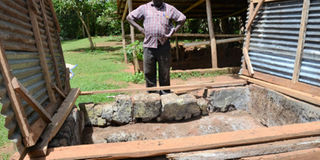Brewer’s waste will fatten your cows

Mugerwa stands at his six-tonne ensiling hole that can keep brewer’s mash for up to two months. Photo by George Katongole
Smallholder farmers should always be on the lookout for ways of cutting feed costs without compromising animal productivity and health.
There are several ways of cutting these costs. Traditionally, poultry is tossed with kitchen scraps or served with greens in case they are not on free range.
But for urban cattle farmers, brewer’s waste is a food supplement you may have to consider only that it is not often available for free. But it remains an excellent source of nutrition. Brewer’s waste is a by-product of brewery, consisting of the spent grains left after the production of beer and other malt products.
Nutritious
According to animal nutrition website, feedtables.com, brewer’s grains obtained from barley have a high nutrition value. Feed tables lists the main constituents as dry matter, crude protein (23.9 per cent), crude fibre (14.2 per cent), crude fat (5.9 per cent), ash, starch and sugars.
Brewer’s waste also contains useful mineral elements especially calcium, phosphorous, magnesium, potassium and iron, among others. Other components are fatty acids, vitamins and pigments.
Brewer’s waste can be fed to most forms of livestock including; ruminants, pigs, poultry, horses and rabbits.
According to James Mugerwa Sebudde, a dairy cattle keeper and extension worker living in Kirangira Village, Mukono District, brewer’s waste is particularly cheap yet it is protein and fibre-rich.
“These leftovers are excellent animal feed for everything from cows to chicken,” Mugerwa says.
Availability
Brewer’s waste is mainly obtained from Nile Breweries Limited in Jinja and Uganda Breweries Limited in Luzira.
Beer companies normally give it for free if you can transport it. Craft beer companies, microbreweries and local brew producers are the other sources one can check with.
“Beer is very popular and that means brewer’s mash is readily available in most parts of the country. One just needs to make arrangements with breweries,” Mugerwa explains.
Mugerwa normally stocks six tonnes which he uses to feed his animals for two months.
When delivered at his farm, each kilogramme costs an estimated Shs130. He says this is comparatively cheaper to dairy meal, the direct substitute.
Going by the current prices, dairy meal costs between Shs800 and Shs1,200 per kilogramme. Yet dairy meal is always complemented by highly priced dairy concentrates that costs around Shs2,200 per kilogramme. “This has saved me a lot of expenses,” Mugerwa explains.
Ration
Mugerwa complements brewer’s waste with silage and fresh vegetation to achieve a balanced diet.
He explains that ruminants love the high fibre content of the waste yet the low degradability protein is even excellent for dairy cattle. Mugerwa, though cautions that pigs, goats, sheep, rabbits and poultry require a moderate quantity in their diet. “It should not be the staple food for smaller animals,” he says.
His recommendation is to feed brewer’s waste between 20-40 per cent.
But because it is cheaper to obtain brewer’s waste in bulk, not all can be used quickly. It is recommended that the waste is used in three days after being obtained.
Ensiling
“When it sits around for longer than three days, it grows mould on top of attracting houseflies,” Mugerwa says. The smell could become unbearable afterwards.
This calls for ensiling to enable future use. According to Mugerwa, brewer’s waste can be preserved in three major ways.
One is to keep it on the surface. Only that this does not last for long. The second option is to keep it in airtight plastic or steel drums or barrels. But with its high moisture content, the waste is very corrosive to steel drums.
That is why Mugerwa prefers digging a hole to control the fermentation process while keeping the feed from the rain.
But this hole has specific dimensions. He recommends a hole as long as five feet, 2.5ft breadth and 3ft wide.
It must have a shallow end of 2ft while the deep end is preferably 3ft. A one-foot squared hole is dug at the deep end to enable draining of any residual liquids.
At the beginning, salt can be sprinkled on the sides of the hole to act as a disinfectant.
The hole is completed with a roof shelter from rainfall.
“This house can be repaired regularly by replacing the roof,” Mugerwa says.
According to him, brewer’s mash is a great sustainable resource for any small agricultural enterprise.




